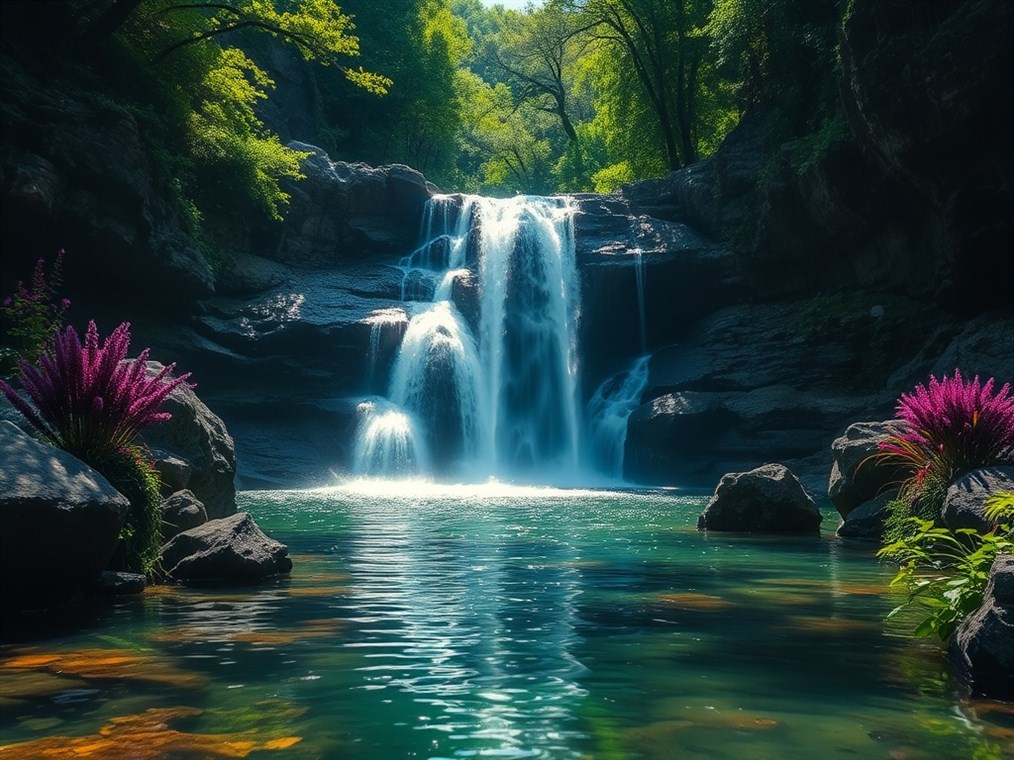
The Secret Life of Waterfall Water: It’s More Than Just a Pretty Picture
FactsThe Secret Life of Waterfall Water: It’s More Than Just a Pretty Picture
Waterfalls! We’ve all been mesmerized by them, right? These incredible displays of nature’s raw power and beauty have been captivating us since, well, forever. But have you ever paused to think about what exactly makes up the water that’s thundering over those rocky edges? Turns out, it’s a bit more complicated – and way more interesting – than you might expect.
From Sky to Summit: Where Does Waterfall Water Come From?
Basically, waterfall water starts as precipitation – rain, snow, you name it. This water obediently follows gravity’s pull into rivers and streams. Think of these waterways as a watery highway, often fueled by melting glaciers, hidden underground springs, and smaller streams joining the flow. Eventually, these rivers find a dramatic change in elevation, often where different types of rock meet, and voila – a waterfall is born. So, in essence, the water cascading down is just river water that’s taken a scenic route to a higher altitude.
What’s In Waterfall Water? It’s Not Just H2O, Folks!
Okay, so water (H2O) is the main ingredient, obviously. But waterfall water is far from pure. It’s more like a watery cocktail, influenced by a bunch of different factors:
- Dissolved Minerals: As the water journeys through the landscape, it’s constantly interacting with the soil and rocks, picking up minerals along the way. We’re talking about stuff like calcium, magnesium, sodium, and potassium. The specific mix depends on the local geology. For example, if the water flows through limestone, expect a higher dose of calcium.
- Gases: Just like your favorite soda, water can dissolve gases from the atmosphere, like oxygen and carbon dioxide.
- Organic Matter: Decaying plants and animals also contribute to the mix, adding organic compounds to the water.
- Sediment: Waterfalls can carry sediments, like rocks, gravel, and sand, depending on the flow and surrounding environment.
Is Waterfall Water Safe to Drink? Think Twice!
Now, here’s the million-dollar question: can you drink it? The answer is… it depends, but generally, no, you shouldn’t. The water quality can vary wildly depending on the location and the surrounding environment. In remote, pristine areas, the water might be relatively clean, naturally filtered by rocks and vegetation. But waterfalls near cities or industrial zones? That’s a different story. They can be contaminated with pollutants, bacteria, or nasty chemicals.
Even if the water looks crystal clear, it could be harboring harmful microorganisms like bacteria, viruses, and parasites that can make you seriously ill. Trust me, you don’t want to mess with that! If you’re ever in a survival situation and need to drink from a natural source, always purify the water first. Boiling is your best bet, but water filters or chemical treatments can also do the trick.
Waterfalls: Nature’s Sculptors
Waterfalls aren’t just pretty faces; they’re also powerful forces of nature. The sheer force of the falling water, especially when it’s carrying sediment, slowly but surely erodes the rock at the base, creating a plunge pool. Over time, this erosion can cause the waterfall to retreat upstream, carving out impressive canyons and gorges. The type of rock plays a big role, too. Harder rocks like granite tend to create those dramatic, sheer falls, while softer rocks like sandstone lead to more rounded, irregular shapes.
When Waterfalls Get a Little Extra: Mineral Waterfalls
And then there are the truly unique cases: mineral waterfalls. In certain locations, waterfalls with super-high mineral content can create some seriously bizarre and beautiful formations. Take Hierve el Agua in Oaxaca, Mexico, for example. These “petrified waterfalls” are formed by the slow deposition of minerals over thousands of years. Or consider Pamukkale in Turkey, famous for its stunning terraces of carbonate minerals created by hot springs. It’s like nature’s own art exhibit!
A Never-Ending Cycle
The water in waterfalls is part of a continuous, dynamic cycle. It’s constantly moving, constantly changing. From the moment it falls as precipitation to its journey through rivers and streams, its dramatic plunge over a waterfall, and its eventual return to the ocean, this water shapes our planet, supports countless ecosystems, and inspires awe in all of us. So, next time you find yourself gazing at a majestic waterfall, take a moment to appreciate the incredible journey and complex composition of the water before you. It’s a story worth telling!
You may also like
Disclaimer
Categories
- Climate & Climate Zones
- Data & Analysis
- Earth Science
- Energy & Resources
- Facts
- General Knowledge & Education
- Geology & Landform
- Hiking & Activities
- Historical Aspects
- Human Impact
- Modeling & Prediction
- Natural Environments
- Outdoor Gear
- Polar & Ice Regions
- Regional Specifics
- Review
- Safety & Hazards
- Software & Programming
- Space & Navigation
- Storage
- Water Bodies
- Weather & Forecasts
- Wildlife & Biology
New Posts
- Diving Deep into Tangerine: More Than Just a Sunny Locale
- Jamaica Backpack Daypack Pockets Shopping – Review
- TEOYETTSF Climbing Backpack Multifunction Military – Buying Guide
- The Curious Case of Cavendish’s Classroom: Where Did This Science Star Study?
- Dragon Backpack Insulated Shoulder Daypack – Buying Guide
- ROCKY Hi-Wire Western Boots: A Rugged Review After a Month on the Ranch
- Vertical Curbs: More Than Just Concrete Barriers
- Regatta Modern Mens Amble Boots – Honest Review
- YMGSCC Microfiber Leather Sandals: Beach to Boardwalk, Did They Hold Up?
- Tangier: More Than Just a Backdrop in “Tangerine”
- DJUETRUI Water Shoes: Dive In or Doggy Paddle? A Hands-On Review
- Barefoot Yellow Pattern Hiking 12women – Is It Worth Buying?
- Koa Trees: How Fast Do These Hawaiian Giants Really Grow?
- DDTKLSNV Bucket Hat: Is This Packable Sun Shield Worth the Hype?